In the competitive world of SUVs, two notable contenders have emerged: the Hyundai Tucson and the Renault Espace. Both models embody innovation and advanced technology but cater to slightly different markets. Here, we compare these two appealing vehicles, assessing their technical specifications, innovations, and overall appeal.
Hyundai Tucson vs Renault Espace – Which one offers the better deal?
Everyday use, family trips or long-distance drives – here’s where the differences show.
Discover whether Hyundai Tucson or Renault Espace fits your lifestyle better.
Design and Dimensions
The Hyundai Tucson boasts a stylish and bold exterior, characteristic of the brand’s modern design language. Measuring 4,510 mm in length, 1,865 mm in width, and 1,650 mm in height, it presents a confident stance on the road.
In contrast, the Renault Espace is longer at 4,722 mm but narrower at 1,843 mm and shorter at 1,645 mm in height. The Espace’s design emphasizes practicality, especially for families, with an option for 7 seats, while the Tucson primarily offers a 5-seater configuration.
Powertrains and Performance
Under the hood, the Hyundai Tucson offers a diverse range of engine options, including Diesel MHEV, Petrol MHEV, Petrol, Full Hybrid, and Plugin Hybrid. With power outputs ranging from 136 HP to 252 HP, Tucson ensures versatility to meet various driving needs. Notably, the Tucson accelerates from 0 to 100 km/h in as little as 7.9 seconds, showcasing its sporty credentials when outfitted with the right engine.
On the other hand, the Renault Espace comes equipped with a single Full Hybrid engine producing 200 HP. It accelerates from 0 to 100 km/h in 8.8 seconds, which, while slightly slower than the Tucson’s top performing engine, still provides a brisk driving experience. Both SUVs promise efficient fuel consumption, with the Tucson ranging between 5.1 to 6.8 L/100 km and the Espace impressively achieving just 4.7 L/100 km.
Transmission and Drive
The Tucson offers flexibility with both manual and automatic transmission options, featuring a Dual-Clutch Automatic system for a seamless driving experience. Consumers can also choose between Front-Wheel Drive and All-Wheel Drive configurations, making it adaptable for different terrains.
Conversely, the Renault Espace simplifies options with its automatic gearbox and Front-Wheel Drive setup. This straightforward choice ensures ease of handling, especially for urban environments, although it may lack the off-road capability found in the Tucson’s All-Wheel Drive variant.
Interior and Technology
Hyundai Tucson continues to impress with its tech-savvy interior, designed around driver comfort and connectivity. The SUV features a spacious trunk capacity ranging up to 620 L and comes equipped with the latest infotainment system, which incorporates smartphone integration, navigation, and wireless charging.
The Renault Espace, while slightly behind in trunk capacity at 581 L, shines in its versatile seating arrangements. With its seven-seat configuration, the interior can be adapted to suit passenger or cargo demands. Technological advancements, including an intuitive media system, enhance the driving experience, making it family-friendly.
Efficiency and Environmental Impact
When considering environmental responsibility, both vehicles stand out. The Hyundai Tucson presents CO2 emissions ranging from 126 to 153 g/km depending on the variant, with an efficient fuel consumption profile. The Espace takes the lead regarding eco-friendliness, offering lower CO2 emissions of just 107 g/km, aligning with the growing demand for sustainable vehicles.
Conclusion
The comparison between the Hyundai Tucson and Renault Espace is a testament to the strengths found within modern SUVs. Tucson excels in performance, drivetrain options, and superior acceleration, while the Espace prioritizes sustainability and versatility with its family-friendly features. Ultimately, the choice between the two will largely depend on individual needs—whether one prefers sporty performance or the practicality of space and efficiency.
Here’s where it gets real: The technical differences in detail
Costs and Efficiency:
When it comes to price and running costs, the biggest differences usually appear. This is often where you see which car fits your budget better in the long run.
Hyundai Tucson has a evident advantage in terms of price – it starts at 30600 £, while the Renault Espace costs 37500 £. That’s a price difference of around 6908 £.
Fuel consumption also shows a difference: Hyundai Tucson manages with 1 L and is therefore clearly more efficient than the Renault Espace with 4.90 L. The difference is about 3.90 L per 100 km.
Engine and Performance:
Power, torque and acceleration say a lot about how a car feels on the road. This is where you see which model delivers more driving dynamics.
When it comes to engine power, the Hyundai Tucson has a evident edge – offering 252 HP compared to 200 HP. That’s roughly 52 HP more horsepower.
In acceleration from 0 to 100 km/h, the Hyundai Tucson is slightly quicker – completing the sprint in 7.90 s, while the Renault Espace takes 8.80 s. That’s about 0.90 s faster.
In terms of top speed, the Hyundai Tucson performs a bit better – reaching 204 km/h, while the Renault Espace tops out at 174 km/h. The difference is around 30 km/h.
Space and Everyday Use:
Cabin size, boot volume and payload all play a role in everyday practicality. Here, comfort and flexibility make the difference.
Seats: Renault Espace offers distinct more seating capacity – 7 vs 5.
In curb weight, Hyundai Tucson is slight lighter – 1542 kg compared to 1673 kg. The difference is around 131 kg.
In terms of boot space, the Renault Espace offers slightly more room – 692 L compared to 620 L. That’s a difference of about 72 L.
In maximum load capacity, the Renault Espace performs slightly better – up to 2224 L, which is about 425 L more than the Hyundai Tucson.
When it comes to payload, Renault Espace barely noticeable takes the win – 581 kg compared to 545 kg. That’s a difference of about 36 kg.
Who wins the race?
The Hyundai Tucson proves to be wins the duel decisively and therefore becomes our DriveDuel Champion!
Hyundai Tucson is the better all-rounder in this comparison.
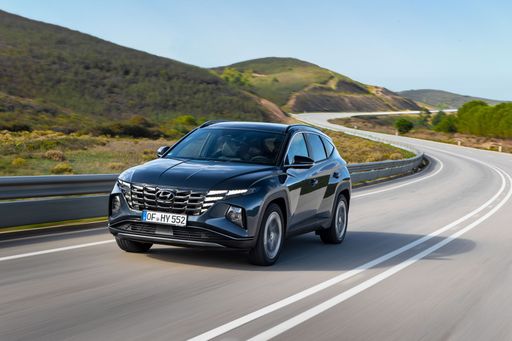 @ Hyundai Motor Company
@ Hyundai Motor Company
Hyundai Tucson
Hyundai Tucson
Hyundai Tucson marries bold, sculpted looks with a clever, roomy cabin that feels smarter than its price tag suggests. It's composed on the road, easy to live with day-to-day, and a sensible choice for buyers who want SUV style without the showroom theatrics.
details @ Hyundai Motor Company
@ Hyundai Motor Company
 @ Hyundai Motor Company
@ Hyundai Motor Company
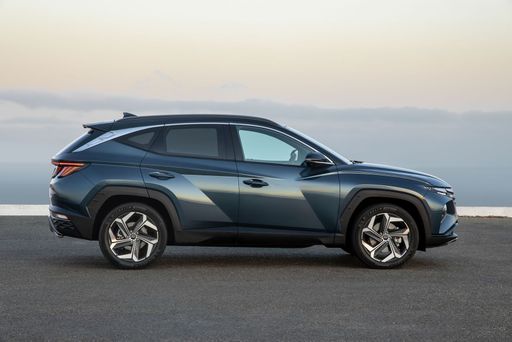 @ Hyundai Motor Company
@ Hyundai Motor Company
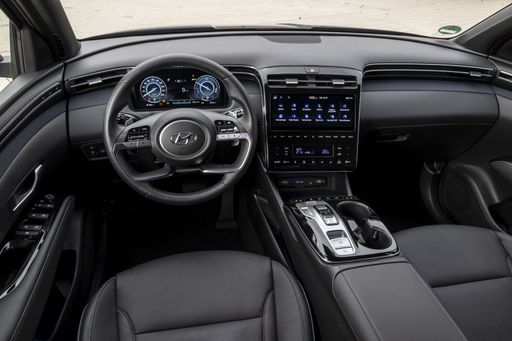 @ Hyundai Motor Company
@ Hyundai Motor Company
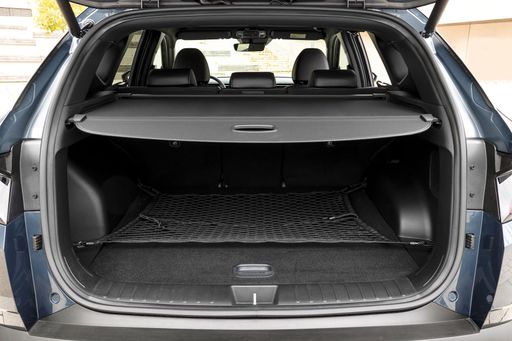 @ Hyundai Motor Company
@ Hyundai Motor Company
Renault Espace
The Renault Espace is the sort of roomy, clever family cruiser that makes long journeys feel effortless, its interior prioritising comfort and practical thinking without drifting into blandness. It won't pretend to be a sports car, but its composed ride, smart packaging and a whisper of French flair make it a sensible and subtly stylish choice for buyers who value space and versatility.
details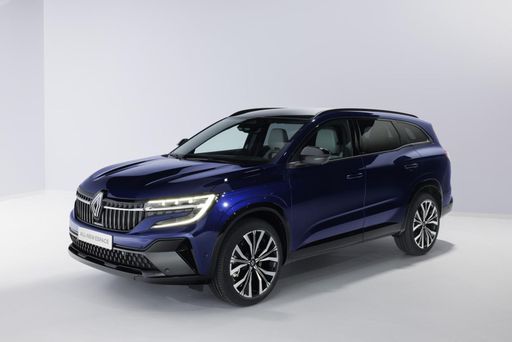 @ Renault Group Media
@ Renault Group Media
 @ Renault Group Media
@ Renault Group Media
 @ Renault Group Media
@ Renault Group Media
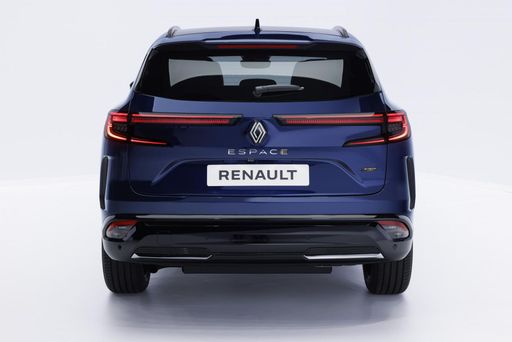 @ Renault Group Media
@ Renault Group Media
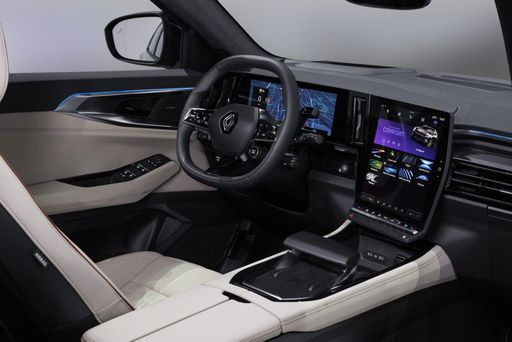 @ Renault Group Media
@ Renault Group Media
 @ Hyundai Motor Company
@ Hyundai Motor Company
|
 @ Renault Group Media
@ Renault Group Media
|
|
|
|
Costs and Consumption |
|
|---|---|
|
Price
30600 - 46300 £
|
Price
37500 - 41400 £
|
|
Consumption L/100km
1 - 7.6 L
|
Consumption L/100km
4.90 L
|
|
Consumption kWh/100km
-
|
Consumption kWh/100km
-
|
|
Electric Range
64 - 70 km
|
Electric Range
-
|
|
Battery Capacity
-
|
Battery Capacity
-
|
|
co2
22 - 172 g/km
|
co2
110 g/km
|
|
Fuel tank capacity
42 - 54 L
|
Fuel tank capacity
55 L
|
Dimensions and Body |
|
|---|---|
|
Body Type
SUV
|
Body Type
SUV
|
|
Seats
5
|
Seats
5 - 7
|
|
Doors
5
|
Doors
5
|
|
Curb weight
1542 - 1889 kg
|
Curb weight
1673 - 1783 kg
|
|
Trunk capacity
546 - 620 L
|
Trunk capacity
212 - 692 L
|
|
Length
4510 - 4535 mm
|
Length
4746 mm
|
|
Width
1865 mm
|
Width
1830 mm
|
|
Height
1650 mm
|
Height
1645 mm
|
|
Max trunk capacity
1721 - 1799 L
|
Max trunk capacity
2054 - 2224 L
|
|
Payload
523 - 545 kg
|
Payload
404 - 581 kg
|
Engine and Performance |
|
|---|---|
|
Engine Type
Diesel MHEV, Plugin Hybrid, Petrol, Full Hybrid
|
Engine Type
Full Hybrid
|
|
Transmission
Automatic, Manuel
|
Transmission
Automatic
|
|
Transmission Detail
Dual-Clutch Automatic, Automatic Gearbox, Manual Gearbox
|
Transmission Detail
Automatic Gearbox
|
|
Drive Type
Front-Wheel Drive, All-Wheel Drive
|
Drive Type
Front-Wheel Drive
|
|
Power HP
136 - 252 HP
|
Power HP
200 HP
|
|
Acceleration 0-100km/h
7.9 - 11.6 s
|
Acceleration 0-100km/h
8.80 s
|
|
Max Speed
180 - 204 km/h
|
Max Speed
174 km/h
|
|
Torque
250 - 379 Nm
|
Torque
-
|
|
Number of Cylinders
4
|
Number of Cylinders
3
|
|
Power kW
100 - 185 kW
|
Power kW
147 kW
|
|
Engine capacity
1598 cm3
|
Engine capacity
1199 cm3
|
General |
|
|---|---|
|
Model Year
2024 - 2025
|
Model Year
2025
|
|
CO2 Efficiency Class
E, B, F, D
|
CO2 Efficiency Class
C
|
|
Brand
Hyundai
|
Brand
Renault
|
What drive types are available for the Hyundai Tucson?
Available configurations include Front-Wheel Drive or All-Wheel Drive.
The prices and data displayed are estimates based on German list prices and may vary by country. This information is not legally binding.
